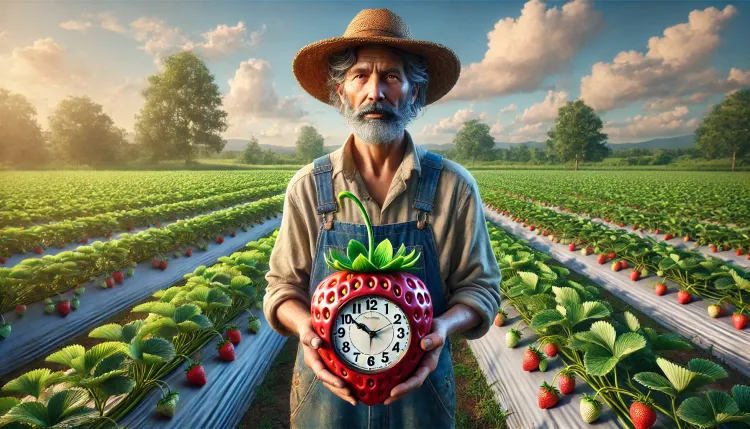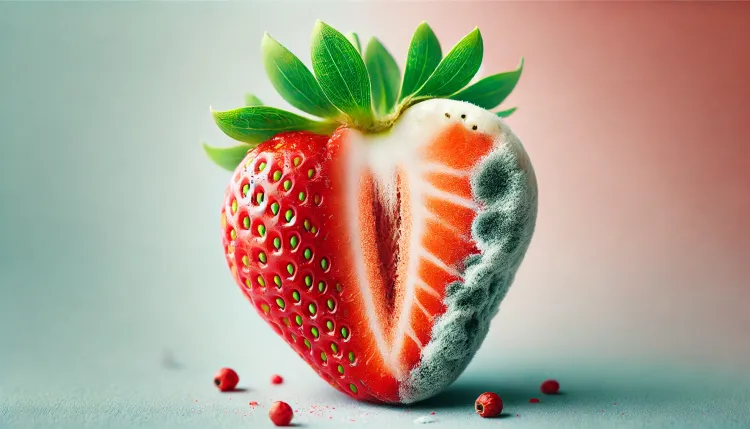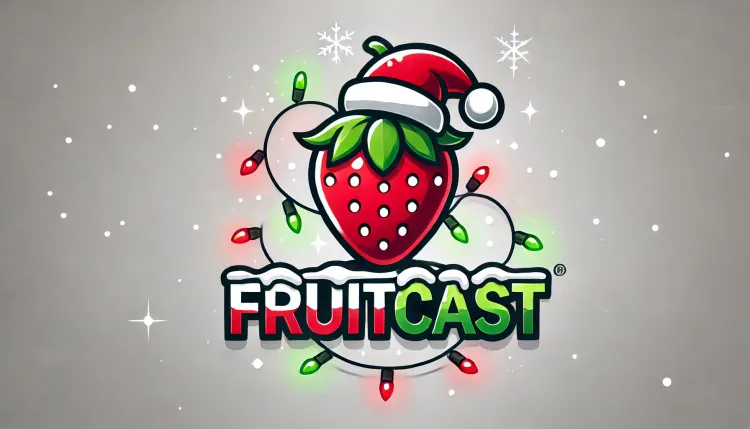From Flower to Fruit

The Strawberry Life Cycle | FruitCast
Understanding the growth stages of strawberries is crucial for optimising yield predictions and determining the best harvest dates. FruitCast's AI software accurately analyses strawberry development at every stage. By scanning key features - such as shape, structure, colour, seed pattern, and ripeness stages - the system provides detailed insights into the crop's progression from early growth to peak maturity. This allows for precise assessments of readiness for harvest.
Tracking the growth of strawberries is essential because their development is closely tied to both visual maturity and environmental factors. Strawberries progress through distinct stages - from flowering to fruiting and ripening - each influenced by thermal units like growing degree days (GDD), growing degree hours (GDH), and solar radiation. These metrics measure the accumulated heat required for physiological processes, including flower differentiation, fruit enlargement, and colour transitions from green to red.
By closely observing visual indicators - such as blossom appearance, fruit colour changes, and seed pattern development - alongside thermal measurements, growers can precisely understand the crop's growth trajectory. This integrated approach enables our platform to schedule harvests accurately from flower to peak ripeness, maximising both yield quality and profitability.
Key Stages in Strawberry Growth
As the plant advances in its nutritional development, it grows larger, with leaves becoming more abundant and deepening in colour. Buds form and bloom during flower differentiation, leading to the flowering stage. As the berry develops, it shifts from green to white to red, expanding in size until it reaches peak ripeness. FruitCast provides real-time updates, ensuring farmers can harvest at the optimal time for maximum quality and profitability.
Stage 1: Flower Initiation and Bloom (2-3 days)

Flower buds emerge and open fully, revealing the central yellow receptacle surrounded by white petals. Pollination occurs during this stage, which is critical for fruit set. Environmental conditions such as temperature and humidity can significantly impact pollination success and subsequent fruit development.
Stage 2: Fruit Set and Green Fruit Development (6-7 days)

After successful pollination, the petals fall away, and the fertilised ovary begins to develop into a green fruit. The berry is small and hard, with seeds (achenes) starting to form on its surface. This stage is sensitive to nutrient availability, particularly nitrogen and calcium, which are vital for cell division and expansion.
Stage 3: Fruit Expansion and White Stage (6-7 days)

The berry increases in size and transitions from green to a pale white colour. Cell enlargement accelerates, and the fruit begins to accumulate sugars. Adequate irrigation and balanced fertilisation are essential during this period to support rapid growth and prevent disorders like fruit deformities.
Stage 4: Colouring and Early Ripening (8-9 days)

The strawberry starts to develop its characteristic red colour, beginning at the tip and progressing toward the calyx. The seeds become more pronounced as the fruit swells. This stage is crucial for flavour development, influenced by factors such as temperature, sunlight exposure, and nutrient levels - especially potassium, which enhances sugar accumulation and colour intensity.
Stage 5: Peak Ripeness and Harvest (2-3 days)

The berry reaches full size and exhibits a uniform deep red colour, indicating maximum sweetness and flavour. The fruit is firm yet juicy, and the seeds are prominently displayed on the surface. Harvesting at this stage ensures the best quality for market standards, with optimal shelf life and consumer appeal.
The average strawberry life cycle from flower initiation to peak ripeness typically spans 25 to 32 days, depending on variety and growing conditions.
The Importance of Picking Strawberries at the Right Time
Harvest timing is critical for UK strawberries. Picking fruit too early, before it reaches full ripeness, can result in poor flavour and colour, failing retailer standards and risking rejection. Overripe berries, harvested after peak ripeness, are more susceptible to damage, have a shortened shelf life, and may spoil during transit. Such quality issues can strain relationships with retailers, jeopardising future contracts. Additionally, leaving overripe berries on the plant diverts nutrients away from new flowers and fruit, reducing overall yield potential.
By understanding the precise timing of the berry growth cycle - specific to available UK strawberry varieties and growing conditions - growers can optimise harvest schedules. Factors like day length, temperature fluctuations, and local climate patterns affect development rates. Recognising these nuances ensures that strawberries are picked at the ideal moment, maintaining quality, retailer trust, and sustained production.
FruitCast’s Precision Tracking
FruitCast's precision tracking helps farmers identify the perfect moment for harvest by monitoring each strawberry's progression through its growth stages. Our technology accounts for the specific conditions of UK strawberry cultivation, providing data that reflects local environmental influences (such as infrastructure specific microclimates). This ensures that strawberries are picked at their peak to maximise quality, marketability, and profitability while preventing unnecessary waste. By empowering growers to make data-driven decisions, FruitCast supports sustainable farming practices and helps farmers get the most from their crop.
Data-Driven Decisions at Every Stage of Strawberry Growth
With hundreds of strawberry varieties cultivated in the UK, FruitCast AI continuously adapts to changing harvest conditions. Strawberry weights and sizes fluctuate throughout the growing season, influenced by nutrient availability and external factors such as weather patterns. Given the variation between different varieties and regions, farmers rely on precise data collection to track gradual changes. Even slight differences in weight can significantly impact total yield by the tonne. FruitCast helps ensure these subtle shifts are captured and accounted for, maximising both accuracy and productivity.
Strawberry growth and yield are affected by factors like temperature, soil moisture, light exposure, and nutrient availability. Optimal growth requires balanced daytime warmth and cooler nights, which enhance sugar accumulation and flavour development. Proper soil moisture ensures effective nutrient uptake and reduces stress, while adequate light levels promote photosynthesis and fruit colouration. Nutrient balance, particularly nitrogen, phosphorus, and potassium, influences berry size, firmness, and sweetness. Managing these variables is essential for producing high-quality fruit that meets market demands.
During periods of high demand in the summer, maintaining consistent quality and sweetness is crucial to meet retailer and consumer expectations. FruitCast helps you monitor these conditions and adjust cultivation practices to maximise yield and quality, ensuring your strawberries meet the desired specifications.
We support our customers by reacting to changes in average berry weights and yields per plant throughout the season. By combining this data with our visual counts from video imaging, we generate precise yield predictions. Leveraging both data sets allows us to provide highly accurate forecasts for total tonnage, optimal harvest dates, and strawberry numbers. This integrated approach ensures farmers have the insights they need to maximise harvest potential, no matter how conditions evolve.
This approach frees up valuable time on the farm by allowing FruitCast to handle the complexities of forecasting. We capture individual data points that contribute to harvest tonnage fluctuations - factors that are easy to miss amidst daily operations. By tracking these nuances, we ensure that nothing goes unnoticed, from subtle changes in weather conditions to variations in plant health and growth stages. With FruitCast managing these details, farmers can focus on other critical tasks, confident that their yield predictions are based on comprehensive, accurate data.
Join the FruitCast Community Today
Becoming part of the FruitCast community means joining a group of forward-thinking farmers who are redefining success in agriculture. The future of farming is data-driven, and FruitCast is here to help you harness the power of your data. With spots filling up quickly for 2025, now is the time to secure your place and start realising the potential of technology-driven agriculture.
Follow Our Socials
For enquiries or to schedule a consultation, reach out to us at [email protected].
Or follow us on LinkedIn at linkedin.com/company/FruitCast to stay updated with our latest insights, tips, and success stories.
Transform Your Farm’s Future with FruitCast - Because Every Berry Matters.



